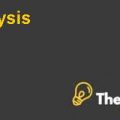
Main Provisions of the Law
- The assistance that was being provided to the Psychiatric institutions shall be shifted away from them and transferred to the community mental health centers. These centers would be organized in a departmental manner where integration would be made possible along with connections with service and community services.
- The psychiatric institutions were not allowed to admit any new patient and construction of the new psychiatric hospitals were also made prohibited.
- Psychiatric wards would be placed in the General Hospitals with 14 to 16 number of beds which is a limited quantity.
Funding and Expenditures
Exhibit 1 illustrates the budget allocation by the Italian government on the mental health system from a proportion of the total health budget allocated by the government. The results indicated that the Italian government has allocated 5% of the total health budget for the mental health systems. Since the reforms have been made in the mental health care in Italy, the proportion of spending by the government has also reduced and is made limited. Traditionally, a large budget would be allocated to the psychiatric and mental hospitals before the reforms because the budget was formed based on historical funding instead of focusing on the need of those hospitals. The need-based approach of allocating budgets required the institutions to increase their quality, capacity, and diversity. By viewing the exhibit 2, the chart shows that Italy makes a total of 5% expenditure in mental health system from its overall budget for health care system(Girolamo, Bassi, Neri, Rugerri, & Santone, 2007).
Description of Epidemiology
Population of Italy with Mental Disorder
While considering the population in the Emilia Romagna region, if we split it by age it reveals the people living in the particular region which includes 21% of population of children between the age group of 0 to 5, whereas, the highest percentage of population group has been the age group between 6 to 10 with 39.2%. While considering the age of 14 to 17, 20.5% of the children population lies in the particular age group. However, when considering the population of the entire age group in the particular region, the data reveals that 4.3% of the population of Emilia Romagna is under the age group of 24 years, whereas, 11.8% of the population falls under the age group between 25 to 34. From the age group of 35 to 44, 20.6% of the population could be found which makes the highest population ratio in the region. However, the highest population of percentage is 22.5% which falls under the age group of 45 to 54. The rest of the percentage falls under the age group of 74 years(World Health Organization, 2008).
Amongst the entire population of Emilia Romagna, 31.3% of individuals are employed in which 12.4% of the individuals live separately and 50% of individuals are single. In this entire population, 4.7% consists of foreign people. However, different results are obtained if we split the numbers on the basis of pathology. The entire population, (27.5%) of the people have development and behavioral disorders, whereas, 16.1% of the individuals are suffering from autism and mental retardation. The highest percentage of individuals suffering from neuropsychology is 43.6% of the entire population of Emilia Romagna(Girolamo, Bassi, Neri, Rugerri, & Santone, 2007).
Current National Mental Health System
There are 21 regions in Italy which are allowed to make their own policies and procedures for the health care services, and maintain their budget. Each of the health care divisions in the country is currently based on decentralized structure and basis through interaction with the Department of Mental Health (DMH). Each region has its own responsibilities in maintaining the quality of care with patients, to comply with the legislated framework, and also to provide an essential level of care as mentioned in the legislation. Currently, there are 211 local departments in the mental health care and services through the country(World Health Organization, 2008).
Department of Mental Health
The Department of Mental Health (DMH) is derived under the Italian National Health Service which is responsible for mental health care in the community. There are three main sectors in the DMH which include adult mental health care, treatment service for addiction, and children and adolescent health care services. The DMH is responsible for planning and management of all the resources which are related from the diagnosis of the patient with mental illness to the treatment and rehabilitation. The adult mental health services are further sub-divided in to four categories which include Community Mental Health Centers (CMHS), Day Care Facilities (DCF), and General Hospital Psychiatric Units (GHPU) which includes up to 15 beds, and the Residential Facilities (RF) where exclusive day and night support is also provided by the institutes...............................
This is just a sample partial case solution. Please place the order on the website to order your own originally done case solution.











